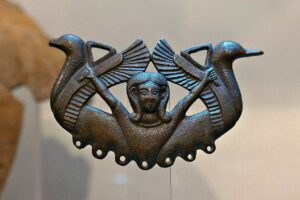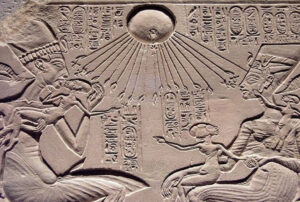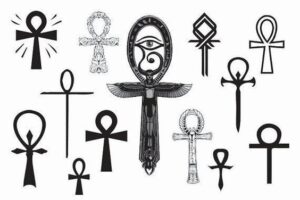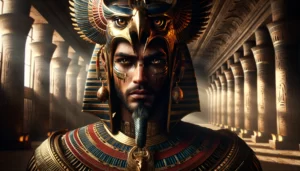Table of Contents
The ancient Egyptian symbol known as the Eye of Horus, or Wedjat/Udjat, represents protection, royal power, and good health. Linked with Horus, the falcon-headed god, it embodies divine insight and healing. Often depicted as a stylized falcon’s eye, it bears a teardrop shape below, attributed to a marking from the god Seth during a battle. Referred to as the “all-seeing eye,” it holds associations with protective amulets, believed to ward off evil and ensure well-being. The symbol is prevalent in ancient Egyptian art, architecture, and burial sites, reflecting its religious and mythological significance.
The Eye of Horus Myth
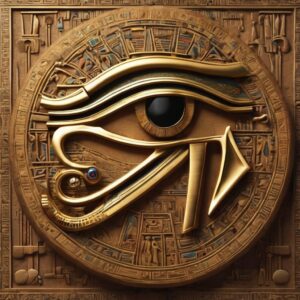
According to myth, Horus engaged in a fierce and enduring battle with his uncle Seth, the god of chaos, to avenge the murder of his father, Osiris. During the struggle, Seth gouged out Horus’s left eye. This event symbolized not only the cosmic conflict between order and chaos but also the cyclical nature of life, death, and rebirth.
Transforming into a powerful and enduring symbol, the Eye of Horus, symbolizing the falcon god’s wounded eye, connects to protection, healing, and restoration. The missing part, depicted as a teardrop or wedge, symbolizes the fraction lost in the conflict with Seth. This design, integral to the symbol’s representation, has ties to fractions and mathematical concepts in ancient Egyptian culture.
Moreover, the Eye of Horus holds broader cosmic significance, often equating with the sun and the moon. The left eye, symbolizing the lunar aspect, links to healing, intuition, and the feminine, while the right eye, representing the solar aspect, associates with power, clarity, and the masculine.
Widely used as a protective amulet in ancient Egypt, the Eye of Horus was believed to ward off evil and bring blessings. Its enduring presence in Egyptian art, hieroglyphs, and funerary contexts underscores profound cultural and spiritual significance. It transcends mythology, becoming an enduring symbol of divine insight and safeguarding.
Other Myths
The Eye of Horus, tied to the myth of Horus and Seth, centrally provides protection and healing. Notably, variations exist, including a narrative restoring Horus’s health post-battle with Seth.
In one myth version, during the conflict, Seth gouged out Horus’s left eye, causing damage. Thoth, the god of wisdom and magic, played a crucial role in the healing. Using magical powers, Thoth restored the eye, transforming it into the Eye of Horus.
Associating with the narrative of its restoration, this distinctive symbol, marked with divisions, links each part to a specific fraction. It is believed that Thoth employed these fractions in a magical incantation for healing, introducing a mathematical and mystical layer to the myth. This highlights the symbolism of completeness and life’s cyclical nature.
While the broader conflict between Horus and Seth remains central to the theme of the Eye of Horus, its symbolism of protection and healing, different sources and interpretations within ancient Egyptian religious texts may reveal variations in the details of the myths.
Eye of Ra
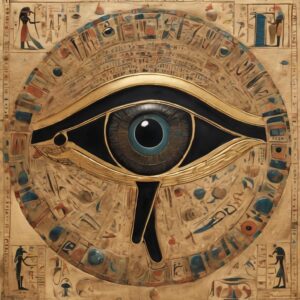
The Eye of Ra and the Eye of Horus are closely related symbols in ancient Egyptian mythology, often representing different aspects of the same underlying concept. Both symbols are associated with protection, healing, and divine power, but they emphasize different facets of the sun god.
- Eye of Ra. The Eye of Ra, specifically linked to the sun god Ra (Re), one of the most crucial deities in the Egyptian pantheon, is often portrayed as a right eye. It symbolizes the sun’s fiery, destructive aspects, with the eye’s journey across the sky representing the sun’s daily cycle.
- Eye of Horus (Eye of Udjat or Wedjat). On the other hand, the Eye of Horus, linked with Horus, the falcon-headed god, represents balance and protection. It’s often depicted as the left eye, with a mythological origin intertwined with the conflict between Horus and Seth.
While the symbols have distinct associations, they are frequently interchangeable, and their representations often merge in art and religious contexts. The combination of the two eyes, known as the “udjat eye,” signifies a unified symbol of cosmic balance, protection, and the cyclical nature of life, death, and rebirth.
The Eyes of Ra and Horus are powerful protective symbols, and their amuletic use was widespread in ancient Egypt. The choice of which eye to use often depended on the specific context and the desired symbolism. Both eyes reflect the profound importance of solar and lunar symbolism in Egyptian religion and cosmology.
Modern Culture
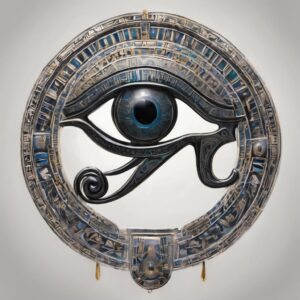
The Eye of Horus and the Eye of Ra continue to have symbolic significance in modern culture, often transcending their ancient Egyptian origins and finding diverse interpretations. Here are a few ways in which these symbols are still present in contemporary contexts:
Tattoos and Jewelry. The Eye of Horus and the Eye of Ra are popular motifs for tattoos and jewelry. Many people choose these symbols for their aesthetic appeal and the deep meanings associated with protection, insight, and balance.
Occult and Spiritual Practices. Some modern spiritual and occult traditions incorporate the Eyes into rituals and symbolic practices. Their ancient associations with protection and divine insight resonate with individuals seeking spiritual guidance.
Art and Design. Contemporary artists and designers often draw inspiration from ancient symbols, including the Eyes of Ra and Horus. These symbols may appear in various forms in paintings, sculptures, and digital art, infusing modern creations with a touch of ancient mysticism.
Popular Culture. The symbols occasionally make appearances in popular culture, including movies, video games, and literature. Sometimes, the eyes are used to convey themes of mysticism, magic, or protection.
Fashion and Merchandise. The distinctive and visually appealing nature of the symbols has made them popular in the fashion industry. Clothing, accessories, and merchandise may feature the Eyes of Ra and Horus as decorative elements.
New Age and Wellness Practices. In New Age and wellness communities, symbols are embraced for spiritual and healing properties. Individuals incorporate them into meditation and use them as visual aids for positive energy.
Contemporary interpretations may not always align with ancient meanings, yet the Eyes of Ra and Horus captivate diverse cultures, attesting to enduring symbol power.
FAQ
Is the Eye of Horus Good or Bad?
The Eye of Horus is generally considered a symbol of protection and good luck. It was believed to have protective qualities, guarding against evil forces and promoting well-being.
Meaning of 𓂀 ?
The symbol "𓂀" is an Egyptian hieroglyph that represents an "ankh," a symbol for life.
What Happens When You Wear the Eye of Horus?
Wearing the Eye of Horus is not believed to have any specific mystical effects. It is primarily a symbol, and its significance is more cultural and spiritual rather than resulting in any tangible outcomes.
Is the Eye of Horus Bad Luck?
No, the Eye of Horus is not generally considered bad luck. As mentioned earlier, it is seen as a symbol of protection and is associated with positive qualities.
Is the Eye of Ra Feminine?
Both the Eye of Horus and the Eye of Ra are associated with feminine deities. The Eye of Ra, in particular, is often linked to the goddesses Sekhmet and Hathor.
Is the Eye of Ra Left or Right?
The Eye of Ra is sometimes associated with the right eye, while the Eye of Horus is associated with the left eye. This is part of the mythology involving the god Ra and his eye being injured and later healed.
Who Uses the Eye of Horus?
The Eye of Horus was widely used in ancient Egypt and is still used today as a symbol in various contexts. It has become a popular symbol in jewelry, art, and tattoos.
Is the Eye of Horus Female?
The Eye of Horus is not a deity itself but is associated with the goddesses Hathor and Sekhmet. In that sense, it can be linked to feminine energy.
Can Men Wear the Eye of Horus?
Yes, both men and women can wear the Eye of Horus. It is a symbol with cultural and spiritual significance, and its use is not restricted by gender.
Can Non-Egyptians Wear the Eye of Horus?
The Eye of Horus has transcended its cultural origins and is embraced by people around the world. Non-Egyptians can and do wear the Eye of Horus as a symbol of protection and cultural appreciation.

